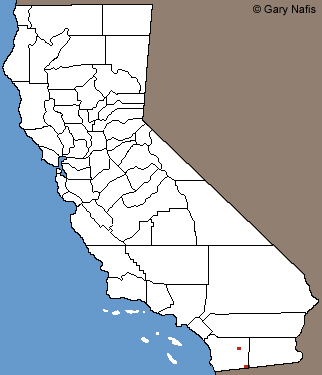|
 |
| Adult, San Diego County, near Baja California border |
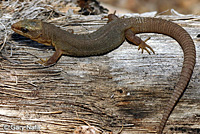 |
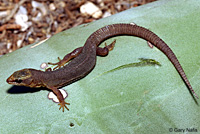 |
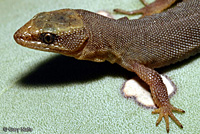 |
| Adult, San Diego County, near Baja California border |
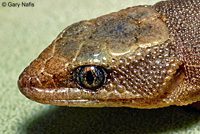 |
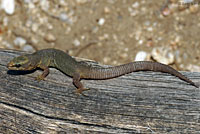 |
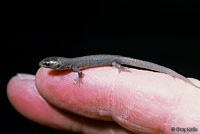 |
| Adult, San Diego County, near Baja California border |
Juvenile, San Diego County |
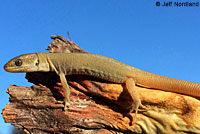 |
 |
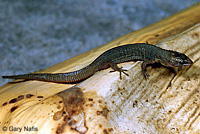 |
| Adult, Scissors Crossing, San Diego County © Jeff Nordland |
Adult, San Diego County
|
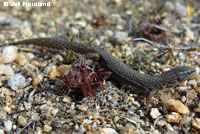 |
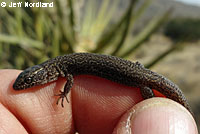 |
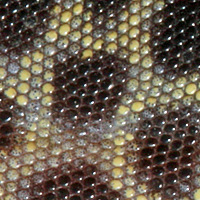 |
Adult, Scissors Crossing, San Diego County © Jeff Nordland
This lizard has been identified as Xantusia vigilis, but since appearance alone cannot determine the species, it could be X. wigginsi, which has also been found at this location. |
The Night Lizards, genus Xantusia, have small granular scales on soft skin.
X. henshawi is seen here. |
| |
|
|
| Wiggins' Night Lizards from Baja California |
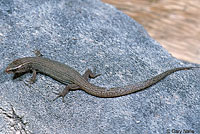 |
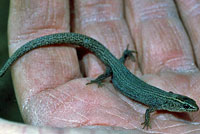 |
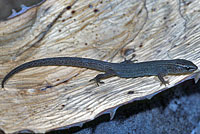 |
| Adult, Desierto Central |
Adult, Desierto Central |
Adult, Desierto Central |
| |
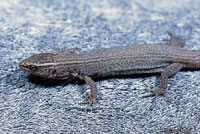 |
|
| |
Adult, Desierto Central |
|
| |
|
|
| Habitat |
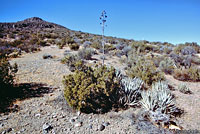 |
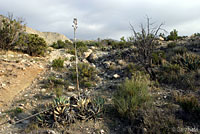 |
|
Habitat, San Diego County,
near the Baja California border |
Habitat, San Diego County,
near the Baja California border |
|
Here are more pictures of this lizard and its habitat in Baja California
|
| Description |
| |
| Size |
Adults grow up to 1.7 inches long from snout to vent (4.4 cm).
|
| Appearance |
| A small thin lizard with soft skin with fine granular scales on most of the body, a head covered with large plates, lidless eyes with vertical pupils, a gular fold, and a detachable tail. |
| Color and Pattern |
Color is grayish brown to rusty brown with black spots, which sometimes fuse together to form thin lines.
The dark spots on the tail are larger.
Sometimes a lizard will be completely unspotted.
A narrow beige stripe, edged in black, usually extends from the eye to the shoulder and may extend along the sides of the entire body.
The underside is whitish-yellow and made up of large square scales. |
| Male / Female Differences |
Males have enlarged femoral pores.
|
| Life History and Behavior |
Activity |
Not much is known about X. wigginsi in California, or in Baja California.
It is certainly diurnal, sedentary, and rarely observed, spending most of its life undercover in and underneath fallen vegetation and debris, and not typically active on the surface away from cover.
According to Grismer it is probably active all year long with peaks of activity in the spring and fall.
(I have found them in mid December inland from Bahia de Los Angeles in Baja California del Norte.) |
| Defense |
When frightened, runs away quickly and dashes under cover. The tail breaks off easily and continues wriggling to distract would-be predators as the lizard runs away as you can see in this video of X. vigilis.
This does not hurt the lizard, although it might suffer from the stress of attempted predation, the loss of fatty energy that is stored in the tail, and have difficulties finding a mate during breeding season due to a less healthy appearance.
More information about tail loss and regeneration. |
| Diet and Feeding |
| Eats small invertebrates inhabiting the decaying vegetation in which it lives including ants, termites, beetles, caterpillars, crickets, and spid |
| Reproduction |
Live-bearing.
Usually gives birth to two young during the fall.
|
| Habitat |
Habitat in California is rocky Desert scrub with abundant yucca.
|
| Geographical Range |
In California, found at Scissors Crossing in San Diego County, and at a location east of Jacumba near the border with Baja California.
Found south of California through the Baja California peninsula to the Vizcaino region of Baja California del Sur.
(X. v. vigilis has been found south of Scissors Crossing in Mason Valley and Little Blair Valley, between the two known populations of X. wigginsi. The Scissors Crossing population may be isolated or the two species may overlap.)
|
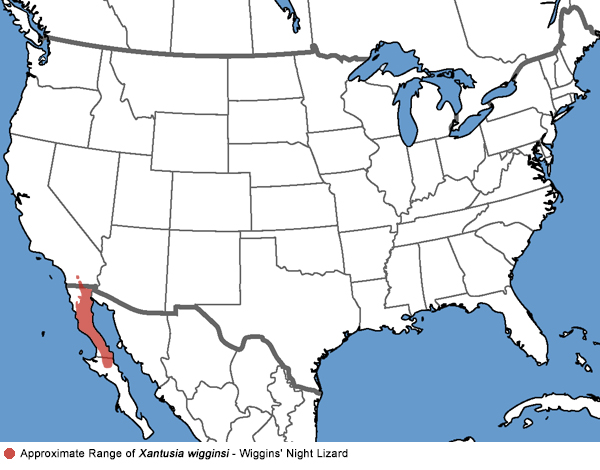 |
| Notes on Taxonomy |
Leavitt et al, 2007, using nuclear DNA studies, found two populations of X. wigginsi in southeastern San Diego county. They also provide support for the recognition of X. wigginsi as a full species.
---------------------------------------------------------------------------------------------------------------------------------------------------------------------
Using nuclear DNA studies, Leavitt et al, 2007, concluded that "...the Xantusia vigilis group continues to reveal multiple unrecognized cryptic species. They provide support for the recognition of new species within the X. vigilis complex, including X. wigginsi in California, but they continue to recognize the subspecies X. v. vigilis and X. v.sierrae. In addition, they identify several major clades in the X. vigilis group, four of which occur in California -
X. vigilis
X. wigginsi
Yucca Valley clade
San Jacinto clade
The other three clades are
X. arizonae
X. bezyi
X. sonora
"Both the San Jacinto and Yucca Valley mitochondrial clades in southern California appear to be of ancient origin... and nuclear data also support their evolutionary independence." These two clades are related to X. wigginsi, but they did not group them with X. wigginsi or X. vigilis, nor did they describe them as independent species, and neither did Robert L. Bezy, one of the co-authors, in his book on Xantusia published in 2019, so I have kept them as X. vigilis pending further research.
---------------------------------------------------------------------------------------------------------------------------------------------------------------------
Several subspecies of Xantusia vigilis were traditionally recognized before X. sierrae and X. wigginsi were elevated to full species, including three in California:
X. v. vigilis
X. v. sierrae
X. v. wigginsi in Baja California.
---------------------------------------------------------------------------------------------------------------------------------------------------------------------
According to Grismer, 2002, X. vigilis occurs in the northern part of the state of Baja California, while X. wigginsi occurs in the southern half of the state into northern Baja California Sur. Stebbins & McGinnis, 2018, also shows the distribution of the two species in this way.
---------------------------------------------------------------------------------------------------------------------------------------------------------------------
"The standard English name for this clade has been changed (by adding “Northern”), following Bezy (2019, Night Lizards, Eco Herpetological Publishing), to eliminate redundancy with the English name of the clade Xantusiidae."
(Nicholson, K. E. (ed.). 2025 SSAR Scientific and Standard English Names List)
---------------------------------------------------------------------------------------------------------------------------------------------------------------------
Alternate and Previous Names (Synonyms)
Xantusia vigilis wigginsi
Baja California Night Lizard
|
| Conservation Issues (Conservation Status) |
| None |
|
|
Taxonomy |
| Family |
Xantusiidae |
Night Lizards |
Baird, 1858 |
| Genus |
Xantusia |
Northern Night Lizards |
Baird, 1859 “1858” |
Species
|
wigginsi
|
Wiggins' Night Lizard |
Savage, 1952 |
|
Original Description |
Xantusia vigilis - Baird, 1858 - Proc. Acad. Nat. Sci. Philadelphia, Vol. 10, p. 255
from Original Description Citations for the Reptiles and Amphibians of North America © Ellin Beltz
Eponyms
First described by Savage, 1952, the specific name "Xantusia wigginsi" and the common name "Wiggins' Night Lizard" honor Ira L. Wiggins, one of the original collectors of the type.
See: Biographies of Persons Honored in the Herpetological Nomenclature © Ellin Beltz
|
|
Meaning of the Scientific Name |
Xantusia - honors Xantus, John
vigilis - Latin = alert or watchful - possibly refers to the lack of eyelids
wigginsi -
(Most likely named after ? Wiggins by Savage in 1952 when he described this subspecies.)
from Names of the Reptiles and Amphibians of North America Ellin Beltz, 2003
|
|
Related or Similar California Lizards |
X. henshawi - Granite Night Lizard
X. gracilis - Sandstone Night Lizard
X. sierrae - Sierra Night Lizard
X. vigilis - Yucca Night Lizard
X. r. reticulata - San Clemente Night Lizard
|
|
More Information and References |
California Department of Fish and Wildlife
Robert L. Bezy. Night Lizards: Field Memoirs and a Summary of the Xantusiidae. ECO Herpetological Publishing & Distribution. 2019.
Hansen, Robert W. and Shedd, Jackson D. California Amphibians and Reptiles. (Princeton Field Guides.) Princeton University Press, 2025.
Stebbins, Robert C., and McGinnis, Samuel M. Field Guide to Amphibians and Reptiles of California: Revised Edition (California Natural History Guides) University of California Press, 2012.
Stebbins, Robert C. California Amphibians and Reptiles. The University of California Press, 1972.
Flaxington, William C. Amphibians and Reptiles of California: Field Observations, Distribution, and Natural History. Fieldnotes Press, Anaheim, California, 2021.
Nicholson, K. E. (ed.). 2025. Scientific and Standard English Names of Amphibians and Reptiles of North America North of Mexico, with Comments Regarding Confidence in Our Understanding. Ninth Edition. Society for the Study of Amphibians and Reptiles. [SSAR] 87pp.
Grismer, L. Lee. Amphibians and Reptiles of Baja California, Including Its Pacific Islands and the Islands in the Sea of Cortés. The University of California Press, 2002.
McPeak, Ron H. Amphibians and Reptiles of Baja California. Sea Challengers, 2000.
Samuel M. McGinnis and Robert C. Stebbins. Peterson Field Guide to Western Reptiles & Amphibians. 4th Edition. Houghton Mifflin Harcourt Publishing Company, 2018.
Stebbins, Robert C. A Field Guide to Western Reptiles and Amphibians. 3rd Edition. Houghton Mifflin Company, 2003.
The Reptile Database
Stebbins, Robert C. A Field Guide to Western Reptiles and Amphibians. 3rd Edition. Houghton Mifflin Company, 2003.
Bartlett, R. D. & Patricia P. Bartlett. Guide and Reference to the Turtles and Lizards of Western North America (North of Mexico) and Hawaii. University Press of Florida, 2009.
Jones, Lawrence, Rob Lovich, editors. Lizards of the American Southwest: A Photographic Field Guide. Rio Nuevo Publishers, 2009.
Smith, Hobart M. Handbook of Lizards, Lizards of the United States and of Canada. Cornell University Press, 1946.
Taylor, Emily. California Lizards and How to Find Them. Heyday, Berkeley, California. 2025.
DEAN H. LEAVITT, ROBERT L. BEZY, KEITH A. CRANDALL, JACK W. SITES JR (2007)
Multi-locus DNA sequence data reveal a history of deep cryptic vicariance and habitat-driven convergence in the desert night lizard Xantusia vigilis species complex (Squamata: Xantusiidae)
Molecular Ecology 16 (21), 4455–4481.
Studies on the Lizard Family Xantusiidae I. The Systematic Status of the Baja California Night Lizards Allied to Xantusia Vigilis, with the Description of a New Subspecies
Jay M. Savage
American Midland Naturalist, Vol. 48, No. 2 (Sep., 1952), pp. 467-479
doi:10.2307/2422261
|
|
|
The following conservation status listings for this animal are taken from the July 2025 State of California Special Animals List and the July 2025 Federally Listed Endangered and Threatened Animals of California list (unless indicated otherwise below.) Both lists are produced by multiple agencies every year, and sometimes more than once per year, so the conservation status listing information found below might not be from the most recent lists, but they don't change a great deal from year to year.. To make sure you are seeing the most recent listings, go to this California Department of Fish and Wildlife web page where you can search for and download both lists:
https://www.wildlife.ca.gov/Data/CNDDB/Plants-and-Animals.
A detailed explanation of the meaning of the status listing symbols can be found at the beginning of the two lists. For quick reference, I have included them on my Special Status Information page.
If no status is listed here, the animal is not included on either list. This most likely indicates that there are no serious conservation concerns for the animal. To find out more about an animal's status you can also go to the NatureServe and IUCN websites to check their rankings.
Check the current California Department of Fish and Wildlife sport fishing regulations to find out if this animal can be legally pursued and handled or collected with possession of a current fishing license. You can also look at the summary of the sport fishing regulations as they apply only to reptiles and amphibians that has been made for this website.
This animal is not included on the Special Animals List, most likely because its occurrance in California was only recently discovered.
|
| Organization |
Status Listing |
Notes |
| NatureServe Global Ranking |
|
|
| NatureServe State Ranking |
|
|
| U.S. Endangered Species Act (ESA) |
None |
|
| California Endangered Species Act (CESA) |
None |
|
| California Department of Fish and Wildlife |
None |
|
| Bureau of Land Management |
None |
|
| USDA Forest Service |
None |
|
| IUCN |
|
|
|
|




















